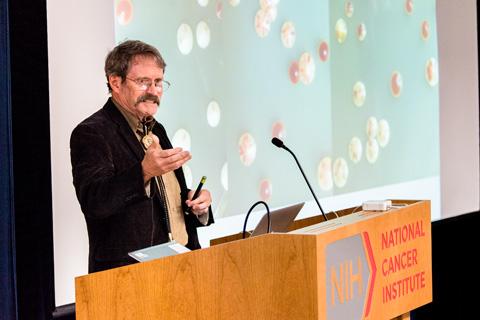Jeffrey Strathern, Ph.D., has hung up his lab coat and donned a sailor’s cap after 32 years of advancing science in areas such as genetics and genomics, chromosome biology, molecular biology, and biochemistry.
Strathern officially retired on May 27. Before he left, he addressed a packed auditorium of friends and colleagues after his final faculty seminar and spoke of his plans to spend time with his family, work on his farm, and take his 32-foot sailing catamaran throughout the United States and Gulf of Mexico and along the eastern seaboard.
Strathern is leaving his roles as chief of the Gene Regulation and Chromosome Biology Laboratory (GRCBL), head of the Genome Recombination and Regulation Section, and as deputy director for the Center for Cancer Research (CCR), NCI.
By Strathern’s estimation, one of his lab’s greatest accomplishments was solving the problem of developing a genetic assay for errors in RNA synthesis, allowing his colleagues to isolate RNA polymerase mutants with reduced fidelity and study the consequences of mistakes in RNA synthesis.
He was awarded the Ira Herskowitz Award from the Genetics Society of America (shared with Amar Klar and Jim Hicks), and was also elected to the American Academy of Microbiology in 2009.
After receiving his Ph.D. from the University of Oregon’s Institute of Molecular Biology in 1977, Strathern went on to work at the Cold Spring Harbor Laboratory in New York, where he became a senior staff member in the Yeast Genetics Laboratory. This was where he met long-time friend and colleague Stephen Hughes, Ph.D., chief, Retroviral Replication Laboratory, CCR. Their collaboration began through intellectual exchanges on their walks home from Cold Spring Harbor to their adjoining apartments.
“Each of us likes to bounce ideas, experiments, data, and interpretations off the other,” Hughes said. “For that reason, the papers we published together are just the tip of the iceberg; the intellectual interchange was much deeper.”
In 1984, Strathern joined NCI as chief of the GRCBL and pursued the study of genetic recombination and gene regulation mechanisms. Strathern’s lab was on the same floor as Hughes’ lab, and the collaboration continued. Hughes described Strathern’s work ethic as “unrelenting.”
“He and I have worked together on physical as well as intellectual problems,” Hughes said. “Putting up hay, putting in fences, laying concrete, building garages and rooms, raising barns, and hanging doors. He is unafraid in the face of any physical or mental challenge.”
NCI is where Strathern hired Amar Klar, Ph.D., senior investigator, GRCBL, who described Strathern as extremely bright and highly energetic, and someone who would work nonstop without getting tired or complaining.
His fondest memories of working with Strathern were “discussing scientific ideas not yet mature, from starting to finishing a project, sharing lab space, the close association of our families for all these years, and watching our kids grow up together.”
As a deputy director of CCR, Strathern often interacted with the former CCR director, Robert Wiltrout, Ph.D., who said he was always amazed at Strathern’s tireless and detailed critiques of all CCR principal investigators’ (PIs’) research as they prepared for their quadrennial Board of Scientific Counselors reviews.
“That was a very unselfish and exhausting sacrifice he made on behalf of all PIs,” Wiltrout said.
Wiltrout added that Strathern was tireless in his advocacy for PIs and gifted in recognizing potential synergies between scientists from different disciplines, which often resulted in collaborations that would never have occurred without Strathern’s insights.
“Jeff has been one of the most unselfish people I have ever known, extremely fair, and with an almost encyclopedic knowledge of things both scientific and general,” Wiltrout said. “He’s a very special friend whose presence will be sorely missed by all.”
Strathern will officially be designated as a scientist emeritus in the GRCBL in July.



